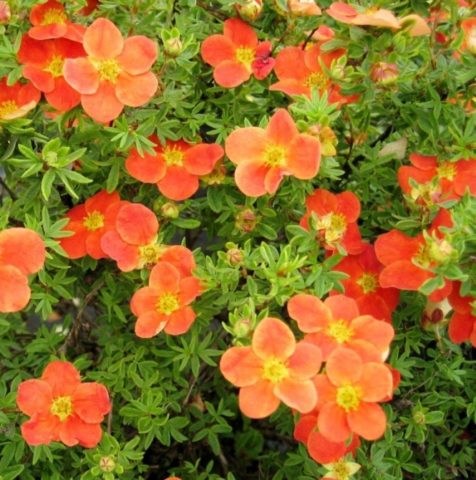Content
Cinquefoil Marion Red Robin differs from the original yellow-flowered variety by the beautiful orange-red hue of its petals. An ornamental variety of shrubby five-leafed summer-autumn flowering was bred on the basis of the long-known Red Ice. The shrub is moisture-loving, winter-hardy, and tolerates urban conditions well.
Description of Potentilla Marion Red Robin
Dwarf cinquefoil Marrob, as the variety is sometimes also called, is characterized by a rounded, compact crown, dense, but small in size - 45-60 cm high, up to 80-100 cm wide. Growth force is average: thin branches grow by 10-15 cm over the season Densely branched, fragile shoots of cinquefoil are red-brown in color, slightly spreading. The small leaves are pinnate, deeply cut to the base, of 5 lobes, sometimes found in 3-7 parts. Green leaf blades turn yellow in autumn. Thanks to the dense arrangement of small cinquefoil leaves, Marion Red Robin creates the impression of a dense crown.
The abundant flowering of the variety begins in June and continues until mid-September or even October in warm weather. The flowers are numerous, with a yellow center, consist of 5 petals of red terracotta color, up to 3.5 cm in diameter. The petals below are much lighter, to a creamy-orange hue. In the sun, the flowers of the Marion Red Robin cinquefoil fade little, but towards the end of flowering they slightly change their shade to a scorched terracotta. In autumn, fruits are formed - prefabricated achenes.
Cinquefoil Marion Red Robin in landscape design
The Red Robin cinquefoil bush is especially picturesque in late summer and early fall. The plant is stable in an urban atmosphere, it is planted in one bush and in groups, combined with other decorative specimens:
- in curbs;
- on discounts;
- in rock gardens and rockeries;
- ground cover for slopes and spacious lawns;
- as a lining for tall bushes or trees with an openwork crown;
- a low hedge for a symbolic breakdown of garden areas.
Planting and caring for cinquefoil Marion Red Robin
Potentilla is planted in early spring or autumn, and plants in containers are moved in the summer. For the shrub, choose a sunny place that can be shaded only for a short time, no longer than 4 hours. The best corner is cozy, without access to strong winds and snow drifts in winter. Ornamental cinquefoil Red Robin grows, as in the photo, lush and blooms profusely in regions of temperate climate, rich in rain.
Preparing the landing site
The Marrob variety develops well in fertile soil and loves loose loam.On sandy loams, the substrate must be enriched with compost or humus. If the area is low, form a mound up to 60 cm high, and arrange a planting hole in it:
- depth and diameter 60 cm;
- the interval between plants is up to 80 cm, for hedges - 40-50 cm.
Landing rules
Proper planting determines the successful development of the shrub over 20-30 years:
- drainage up to 10 cm is placed below; you can use limestone gravel, since Red Robin cinquefoil tolerates alkaline soils well;
- complex fertilizers are added to the prepared enriched substrate, checking the instructions;
- the seedling is placed taking into account the requirement that the root collar is at the same level with the garden soil;
- Having compacted the soil around the bush, water the tree trunk circle with a bucket of water;
- mulch is placed on top.
Watering and fertilizing
Cinquefoil bush grows successfully in loose and moderately moist soils. Areas with stagnant water or too dry are contraindicated for the plant. In the first year of growth, Red Robin cinquefoil bushes are watered up to 2 times a week, preventing the earthen clod from drying out. Adult plants tolerate short-term drought, but such a period affects the splendor of flowering. In summer, regular watering is required, which is accompanied by loosening or mulching the soil. The Red Robin variety is fed in the spring with nitrogen and potassium preparations, and before flowering the bush is supported with potassium-phosphorus. Complex fertilizers for ornamental shrubs are easy to use.
Trimming
The Marion Red variety lends itself well to pruning; crown formation begins in the second or third year of growth. Pruning is carried out in the spring, often late, when it is clear how well the plant survived the winter.Gardeners advise shortening only a third of each developed branch, and leaving young shoots to flower. Thanks to the formation, flowering is more abundant. Sanitary cleaning is carried out in any season, removing damaged shoots.
Preparing for winter
According to the description, the shrubby cinquefoil Marion Red Robin is winter-hardy and tolerates short-term sub-zero temperatures of up to 30 degrees. But in the harsh conditions of snowless and frosty winters in the middle zone, the ornamental bush requires mulching the tree trunk and covering young plants with mats made of natural materials. Frozen shoots are removed and new ones grow to replace them.
Propagation of cinquefoil Marian Red Robin
Like all bushes, the Marion Red variety is propagated:
- cuttings;
- layering;
- division of roots;
- seeds.
Cuttings that take root well are cut in early summer. At the same time, layering is added from the lower branches. Before sowing, the seeds are stratified for 3 months. It has been noticed that under favorable conditions, branches planted near the bush after pruning are accepted and grow.
Diseases and pests
Cinquefoil shrub is little susceptible to diseases and pests. Only if there is a nearby outbreak of rust, anthracnose or powdery mildew, the leaves of the Marion Red variety are also affected. For treatment and prevention, plantings are sprayed with fungicides. A soap or soda solution is used against aphid colonies.
Conclusion
Cinquefoil Marion Red Robin can delight the eye with abundant flowering with careful care and the right choice of location.Regular watering and periodic fertilizing, preserving moisture by mulching, and sheltering young plants for the winter will create the necessary conditions for an ornamental variety.













